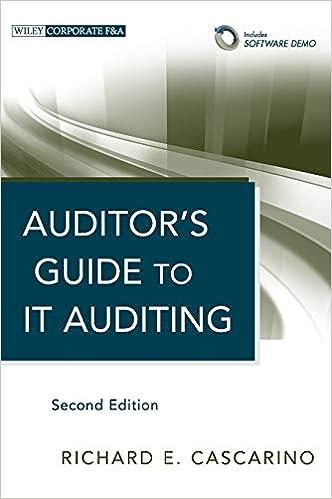Question
11. A service auditors System and Organization Controls (SOC 1, Type 2) report fundamentally provides assurance to a. Readers of the service organizations financial statements
11. A service auditors System and Organization Controls (SOC 1, Type 2) report fundamentally provides assurance to
a. Readers of the service organizations financial statements that there are no material misstatements.
b. User organizations who have outsourced transaction processing to the service organization that there are no misstatements in areas related to these services.
c. Customers of the various user organizations that their data and privacy are secure.
d. User auditors who audit the financial statements of the user organizations that the service organizations relevant controls are suitably designed and operating effectively.
e. Regulatory authorities that the service organization is in compliance with applicable laws and regulations affecting corporate conduct.
12. Which of the following is not specifically associated with control environment as presented in AICPA Professional Standards?
a. Having appropriate human resource policies and procedures in place.
b. Individuals are held accountable for their assigned responsibilities.
c. Those charged with governance provide appropriate oversight of senior management.
d. Having an appropriate segregation of duties to avoid incompatible functions.
e. The organization has a commitment to integrity and high ethical standards.
13. When auditing a material element of a public company's financial statements under PCAOB auditing standards, which of the following activities are required? ["Yes" means required; "No" means not required.]
Perform Risk Assessment Perform Tests of Perform Substantive
Procedures Control Procedures
a. Yes Yes No
b. Yes Yes Yes
c. Yes No Yes
d. Yes No No
e. No No Yes
14. Which of the following best describes the primary purpose of performing a walk through for a small number of revenue-related transactions?
a. To provide feedback that the auditors understanding (and documentation) of internal control is appropriate.
b. To determine whether internal controls are operating effectively.
c. To search for material misstatements in the applicable account balances.
d. To evaluate whether the entitys segregation of duties is proper.
e. To justify the auditors reliance on certain specific internal controls.
15. After obtaining an understanding of an entitys internal control system, an auditor may assess control risk at the maximum level for some assertions because the auditor
a. Believes the internal controls are likely to be effective.
b. Believes that a wholly substantive audit approach is less efficient than a reliance strategy.
c. Believes that the costs associated with performing tests of controls would exceed any potential reduction in substantive testing associated with a reliance strategy.
d. Determines that the relevant internal control components are well documented.
e. Has identified specific internal controls that are likely to prevent misstatements and has performed the appropriate tests of control.
16. Which of the following would most likely be detected by the auditors year-end sales cutoff procedures?
a. Transactions with related parties that were not adequately disclosed.
b. December shipments that were incorrectly recorded as January sales.
c. Overstatements in the recorded balance for the allowance for sales returns.
d. Understatements in the recorded balance for the allowance for uncollectibles.
e. Accounts receivable that have been pledged as collateral for notes payable.
17. Substantive tests of transactions most likely would be performed by the continuing auditor
- When the auditor has performed analytical procedures that suggest the account balance involved is consistent with the auditors expectations.
- When the auditor has performed risk assessment procedures that suggest a low level of risk of material misstatement.
- When the account involved is material and has a high level of activity.
- When the account involved is material and has a low level of activity.
- When the account involved is immaterial.
18. Which of the following most likely would not be considered an inherent limitation of the potential effectiveness of an entitys internal control?
a. A mistake attributable to an employees fatigue due to working long hours.
b. Potential for management override.
c. An employees misjudgment due to a misunderstanding of an assigned task.
d. Collusion among employees.
e. Improper segregation of duties.
19. Which of the following statements concerning material weaknesses and significant deficiencies is correct?
a. An auditor must communicate material weaknesses in writing, but may communicate other significant deficiencies orally instead of in writing.
b. All material weaknesses are significant deficiencies.
c. All significant deficiencies are material weaknesses.
d. An auditor should immediately report all material weaknesses and significant deficiencies discovered during an audit.
e. The auditor is prohibited from reporting any matter that does not rise to the level of a significant deficiency in the auditors management letter.
Step by Step Solution
There are 3 Steps involved in it
Step: 1

Get Instant Access to Expert-Tailored Solutions
See step-by-step solutions with expert insights and AI powered tools for academic success
Step: 2

Step: 3

Ace Your Homework with AI
Get the answers you need in no time with our AI-driven, step-by-step assistance
Get Started


